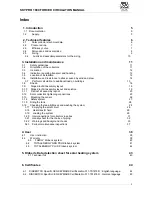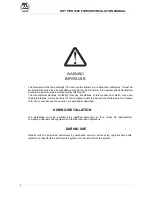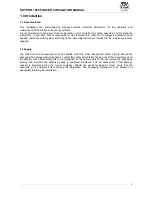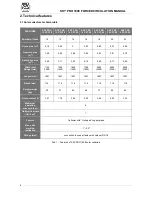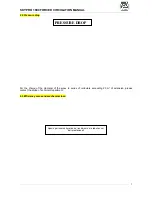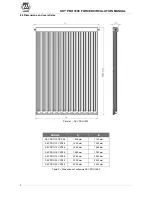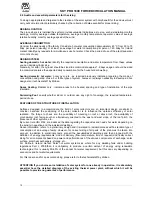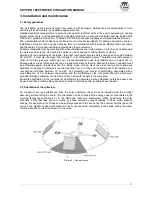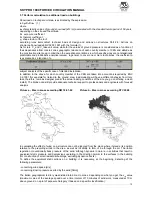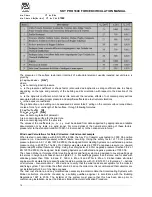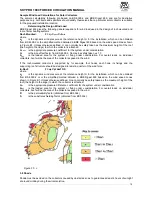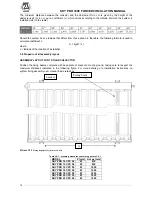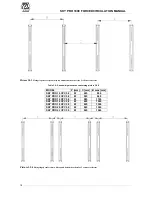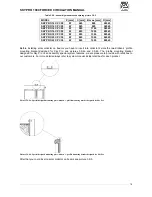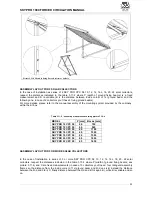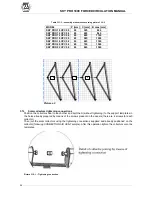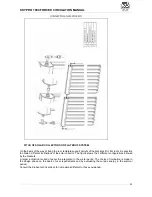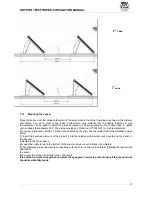
SKY PRO 1800 FORCED CIRCULATION MANUAL
C
C
C
12
Azimut
Angle to the horizontal plane between the orientation of the collectors and the geographic South. If the
collector is facing South, the azimut angle is = 0°, if it is facing East or West it is = 90°C.
Optimal orientation = 0° South
Maximum orientation recommended = 30° South/East - 30° South/West. If the orientation of the pitch
is more than 30°C compared to the South, a double East-West pitch can be installed.
ANY ORIENTATION OF THE MANIFOLDS THAT IS DIFFERENT FROM THOSE STATED IN THIS
MANUAL DOES NOT GUARANTEE THE OPTIMAL PERFORMANCE OF THE SYSTEM.
3.3 Inclination
The angle of the solar collectors with respect to the horizontal line is closely related to the season during
which the system is used mostly. When the system is mainly used during the summer months (camp sites,
pools, buildings used during the summer holidays), it is recommended to apply an angle equal to the latitude
of the location of the installation, reduced by 10-15° so as to favour sunlight absorption with the high sun (L-
10)°, (L-15)°. In the opposite case, i.e. if the system is mainly used in winter, the recommended angle is that
of the latitude increased by 10-15°, (L+10°), (L+15)°. When the system is used continuously throughout the
year, it is recommended to choose an angle equal to the latitude (L)°.
When the solar collectors are to be embedded into the roof for aesthetic purposes, i.e. these will be at the
same angle as the roof, the number of collectors can be increased so as to compensate for the loss in
efficiency caused by the non-optimal angle.
The SKY PRO solar collector can be inclined at an angled that falls between 1° and 90°.
3.4 Indication regarding transport and handling
There are no specific warnings regarding the handling and transport of the solar collectors, if not the usual
cautions to consider when handling fragile objects. The packaged panel must be loaded onto lorries or any
other means of transport in a vertical position.
Wear rubber or PVC gloves during handling, installation and maintenance of the panels, so as to prevent
injury due to the accidental breakage of fragile material, such as glass. The use of protective glasses is also
recommended.
For the use and handling of the anti-freeze heat transfer fluid follow the normal safety and hygiene measures
relative to the use of chemical substances. Also refer to the information contained in the anti-freeze safety
sheet.
3.5 Location of the installation
Ensure that the roof where the solar system will be installed is sufficiently solid to withstand the weight.
3.6 Installation and resistance to stress caused by wind and snow.
The installation of solar collectors on flat and sloped roofs envisions indispensable preliminary checks that
clarify the following critical aspects:
- Static stability of the roof for assembly of the collectors;
- Accessibility of the roof housing the system and sufficient access and freedom of movement in
safety;
- Fixing quality of the structure connections and support devices of the solar collectors to the building
support (loft structure, flat roof structure, etc.).
On the basis of the place of installation selected, the locality, the height from the ground, exposure,
topography of the land, the climatic conditions of the areas, etc. preliminary checks must be made of the
loading conditions owing to the wind (average, peaks due to gusts and the presence of storms) and snow,
based on that required by the Decree of the Ministry of Infrastructure and Transport dated 14 September
2005 – “Technical standards for construction” and subsequent decrees. When calculating the stress
evaluation of individual and combined loads due to wind and snow, a maximum sustainable load of 0.90
kN/m² must be considered, normally on the collector surface. The solar collector has been designed to
adequately withstand severe combined conditions of both wind and snow, which are typical in Italy.
However, if exceptional phenomena are expected or loading will exceed the maximum allowed, additional
protection must be implemented, such as tie-rods are reinforcements that are to be established on site.
Summary of Contents for SKY PRO 10 CPC 58
Page 1: ...TECHNICAL MANUAL SOLAR COLLECTORS SKY PRO 1800 ...
Page 2: ......
Page 47: ...SKY PRO 1800 FORCED CIRCULATION MANUAL C C 47 ...
Page 49: ......



